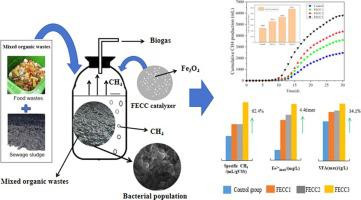Our official English website, www.x-mol.net, welcomes your feedback! (Note: you will need to create a separate account there.)
Effect of ferrite doped sludge-based catalysts on methane production in anaerobic digestion of organic solid waste
Fuel ( IF 7.4 ) Pub Date : 2024-04-13 , DOI: 10.1016/j.fuel.2024.131309 Jiehong Cheng , Renkai Ye , Jun Zhu , Yue Tang , Shouqiang Huang , Dongdong Ge , Zitao Geng
Fuel ( IF 7.4 ) Pub Date : 2024-04-13 , DOI: 10.1016/j.fuel.2024.131309 Jiehong Cheng , Renkai Ye , Jun Zhu , Yue Tang , Shouqiang Huang , Dongdong Ge , Zitao Geng

|
In response to the world-wide call for carbon neutralization, efficiently producing biogas for energy from biomass through anaerobic digestion has become a hot research topic. In this study, ferrite doped sludge-based catalysts were prepared by pyrolysis and carbonization using iron chloride and sludge at different mass ratios of 1:3(FECC1), 2:3(FECC2), and 3:3(FECC3). These catalysts were added to the anaerobic digestion (AD) system to improve biogas production and anaerobic digestion efficiency. The TEM and XRD test results showed that compared with FECC1 and FECC2, the FECC3 nanoparticles had many smooth polyhedral FeO grains with high crystallinity, and the size distribution was from 20 to 120 nm. The above catalysts were tested in batch anaerobic co-digestion of sludge and kitchen waste to investigate their effects on digestion performance. Compared with the other three groups, FECC3 group achieved the highest cumulative methane and biogas production after 30 days of AD. The specific methane production rate for FECC3 reached 133 mL/g VSS, which 32 % and 60 % higher than those in the FECC2 and FECC1 groups, and 135 % higher than those in the blank group, respectively. In addition, FECC3 showed obvious advantages in VSS removal rate, VFA yield enhancement, and Fe concentration increase in the mixture. The abundance of acid-producing bacteria and hydrogenotrophic methane bacteria of FECC3 group increased significantly, which indicated that FECC3 significantly affected microbial community. It could therefore be concluded that the FECC3 group was the best among the three catalysts groups in terms of gas production effect and AD performance.
中文翻译:

铁氧体掺杂污泥基催化剂对有机固体废物厌氧消化甲烷产量的影响
为响应全球碳中和的号召,通过厌氧消化高效生产生物质沼气作为能源已成为研究热点。本研究采用不同质量比1:3(FECC1)、2:3(FECC2)和3:3(FECC3)的氯化铁和污泥,通过热解和碳化制备了铁氧体掺杂污泥基催化剂。这些催化剂被添加到厌氧消化(AD)系统中,以提高沼气产量和厌氧消化效率。 TEM和XRD测试结果表明,与FECC1和FECC2相比,FECC3纳米粒子具有许多光滑的多面体FeO晶粒,结晶度较高,尺寸分布在20至120 nm之间。在污泥和餐厨垃圾的间歇厌氧共消化中测试上述催化剂,以研究其对消化性能的影响。与其他三组相比,FECC3组在AD 30天后获得最高的累计甲烷和沼气产量。 FECC3的比甲烷生产率达到133 mL/g VSS,分别比FECC2和FECC1组高32%和60%,比空白组高135%。此外,FECC3在VSS去除率、VFA产率提高和混合物中Fe浓度增加方面表现出明显的优势。 FECC3组产酸菌和氢营养甲烷菌的丰度显着增加,表明FECC3显着影响了微生物群落。因此可以得出结论,FECC3组在产气效果和AD性能方面是三个催化剂组中最好的。
更新日期:2024-04-13
中文翻译:

铁氧体掺杂污泥基催化剂对有机固体废物厌氧消化甲烷产量的影响
为响应全球碳中和的号召,通过厌氧消化高效生产生物质沼气作为能源已成为研究热点。本研究采用不同质量比1:3(FECC1)、2:3(FECC2)和3:3(FECC3)的氯化铁和污泥,通过热解和碳化制备了铁氧体掺杂污泥基催化剂。这些催化剂被添加到厌氧消化(AD)系统中,以提高沼气产量和厌氧消化效率。 TEM和XRD测试结果表明,与FECC1和FECC2相比,FECC3纳米粒子具有许多光滑的多面体FeO晶粒,结晶度较高,尺寸分布在20至120 nm之间。在污泥和餐厨垃圾的间歇厌氧共消化中测试上述催化剂,以研究其对消化性能的影响。与其他三组相比,FECC3组在AD 30天后获得最高的累计甲烷和沼气产量。 FECC3的比甲烷生产率达到133 mL/g VSS,分别比FECC2和FECC1组高32%和60%,比空白组高135%。此外,FECC3在VSS去除率、VFA产率提高和混合物中Fe浓度增加方面表现出明显的优势。 FECC3组产酸菌和氢营养甲烷菌的丰度显着增加,表明FECC3显着影响了微生物群落。因此可以得出结论,FECC3组在产气效果和AD性能方面是三个催化剂组中最好的。



























 京公网安备 11010802027423号
京公网安备 11010802027423号